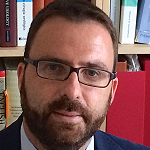
Alberto Budía
Alberto Budía Alba, qualified in Medicine from the Literary University of Valencia (Spain) in 1.994. Resident in Urology from 1996-2001 at La Fe University Hospital in Valencia (Spain). Consultant Urologist at La Fe University Hospital from 2001 to 2012. Head of faculty from 2012 at Lithotripsy and Endourological Unit at La Fe University and Polytechnic Hospital. Doctorate in Medicine and Surgery in 2006. Postdoctoral studies in the field of urinary stones and oncology in Spain in 2002. Member of the Spanish Urological Association, European Urology Association, Endourology Society, Spanish Laparoscopic Society and Valenciana Urological Association. Author of over 80 scientific publications in Journals, books and apps of Urology and reviewer of several international journals.
Lecture : Urinary Stent Complications.
Urinary stents are widely used in obstructive urological pathologies. Their main function is to mantain the drainage of the urine in an obstructed urinary system (upper or lower urinary tract).
The indications of urinary diversion with urinary stents are mainly transient, but in some cases it must be permanent, specially in palliative conditions.
The main complications associated with the use of urinary stents are encrustation and calcification, migration, obstruction, infection, pain and discomfort. The encrustation is the worst complication because it makes very difficult the stent removal. The migration takes the need of a surgical procedure for removing it and the stent must be changed in case of obstruction. Therefore, the symptoms associated with the use of stents can be managed with oral drugs, but they produce a serious loss of quality of life. An improvement of the materials and design of the urinary stents are demanded.
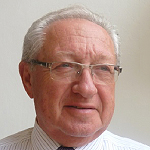
Daniel Yachia
Prof. Daniel Yachia, Urologist. He is the inventor of the self expanding metal (Nitinol) InStent's stents and also the second generation of the hybrid (metal + polymer) Allium stents. Published the 2 editions of the BMA Prize Winning book Stenting the Urinary System. His current activities include a technology for repelling biofilm formation on catheters and stents.
Lecture: ENIUS Master Class.
- Overview on Stents in medicine
How it all started
- General History of Stents in the Urinary Tract
- History of Upper Urinary Tract Stents
Classification of Upper Tract Stents
Ureteral Stents,
UPJ stents,
UVJ stents
Metal vs. polymer made stents
Drug eluting stents . Are they effective?
Is there a place to permanent stents in the upper tract?
Problems with the upper tract stents
The fight for preventing and managing them
- History of Lower Urinary Tract Stents
Prostatic stents
Bladder-neck stents
Bulbar urethral stents
Distal urethral stents
Classification of Lower Tract Stents -
Permanent vs. Removable stents
Non-stent Stents for BPH
Drug eluting stents . Are they effective?
Problems with the lower tract stents
The fight for preventing and managing them
- The problem of biofilm / encrustation formation on urinary tract stents
What was done to prevent/reduce them
- Vascular Stents vs. Urinary Tract Stents
Comparison between vascular and urinary tract stents
Anatomy and physiology of the ureter vs. arteries
Blood vs. Urine
- Materials for producing stents
Metals
Metal alloys
Polymers
Bio-degradable / bio-resorbable metals and polymers
- Engineering problems when designing stents
Asking the hard questions for preventing / reducing problems
Know your adversary before planning your future stent
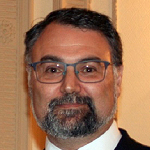
Federico Soria
Dr. Federico Soria (PhD). (Chairman. ENIUS) is Endoscopy Coordinator in Jesus Uson Minimally Invasive Surgery Centre (Spain) a multidisciplinary institution devoted to Research, Innovation and Training in health sciences. Dr. Soria research is focused on Traslational Research (Preclinical) Minimally Invasive Surgery Urological techniques and devices. A special focus area is urinary tract stents design: Biodegradable, Drug eluting stents and metallic designs and Biomaterials in Urology. Researcher in more than 30 research projects, 16 as a principal investigator. Three patents in Biomedicine devices (ureteral stents). More than one hundred scientific papers.
Lecture: Urinary stents. New ideas. Future developments.
Nowadays, urinary stents are part of the daily clinical practice in Urology. Its indications are multiple in both malignant and benign lesions, allowing to ensure urinary drainage and proper healing of the urinary tract. But in spite of their goodness and the extensive list of indications, these scaffold also manifest a series of side effects described in the scientific literature, which affect not only the clinical results but also the quality of life of the patients. The main causes of these effects are related to its design, which has remained practically unchanged since its first description, and which facilitates vesicoureteral reflux and irritation of the bladder trigone, although factors related to its easy bacterial colonization and incrustation also play an important role. On the other hand, metallic stents that in other organic territories, such as the vascular, show very satisfactory results and are fully accepted as daily therapeutic solutions, in the urinary tract they are associated with malignant lesions or currently offer a very limited and restricted use to patients where other alternatives have failed.
It is therefore that plastic or metallic stents continue to be a subject of debate since, although decisive, they are associated with adverse effects that require knowledge of their physiopathology, correct handling and, of course, development and research into new designs, metallic alloys or copolymers and coatings that improve their characteristics, decreasing the morbidity associated with their use and, above all, extending their indications which, due to their limited technological development, remain clearly stagnant.
In this talk we are going to evaluate the new research areas related to urinary stents. Mainly, new designs to reduce side effects, the use of new biomaterials to improve the properties of stents and give stents new properties such as being biodegradable. As well as, the important development that is being done in coatings and antifouling. As well as the possibility of giving stents the ability to release drugs locally. Finally, the future will be composed of biocovered, biomimetic, antibody-coated stents.
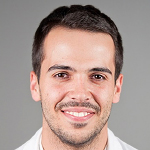
Juan Carlos Gómez Blanco
Industrial engineer from the University of Extremadura in 2014. He is currently a doctoral student with a grant from the General Secretariat for Science, Technology and Innovation. Government of Extremadura. He conducts his doctoral research at the Jesús Usón Minimally Invasive Surgery Centre as a Predoctoral Research Engineer in the Bioengineering and Healthcare Technologies Unit, supporting the unit's different open lines of research, especially in aspects related to mechanical design, simulation and additive manufacturing. His PhD thesis project is based on the improvement of additive manufacturing processes applied to medicine (3D bioprinting), specifically to tissue engineering. In his career as a researcher at the CCMIJU, he has authored and co-authored 17 papers at conferences and 11 articles in national and international journals. He has worked on 9 R&D&I research projects. He is co-inventor of 2 industrial protections. He has been co-director of 2 end-of-degree projects.
Additive manufacturing in urinary stents: Technology and applications
Medical stents are industrially manufactured using very well-defined processes. Fabrication engineers optimizes models and manufacturing procedures to get the cheapest stents. In this sense, 3D printing is presented as an optional method to fabricate stents with intricate geometries. There are 3 main technologies of additive manufacturing that can perform almost any kind of piece. Each one uses a certain type of material that can fit the best to a certain application.
3D printing has 2 main advantages, which are at the same time their main disadvantages, the technology and the material used. Theoretically any kind of material can be suitable for fabricate a piece by the appropriate 3D printing technology but in practice very few materials can be used. Therefore, researchers are trying to adapt and use additive manufacturing technology to perform their medical device designs.
In this session we will discuss about the actual fabrication technology and how 3D printing technology can be used in stent fabrication. We will focus on each type of additive manufacturing system and the materials that can be used.

Julia de la Cruz Conty
Julia E de la Cruz Conty, qualified in Veterinary Medicine from the Complutense University (Madrid, Spain) in 2014. Researcher and PhD Student at the Endoscopy Unit in the “Jesús Usón Minimally Invasive Surgery Centre”. Line of research in Endourology, biodegradable anti-reflux ureteral stents.
Lecture : Urinary stents. Morbidity and impact of quality of life.
Urinary stents are medical devices usually placed to ensure luminal patency of the urinary tract and maintain urine drainage in either obstructive diseases or after urological surgery. However, despite their global use, they are associated to a very high morbidity rate. Stented patients suffer from a wide variety of adverse effects that may impair their quality of life in up to 80% of the cases. Polymeric stents cause irritation of the urothelium, pain, and, in the upper urinary tract, vesicoureteral reflux. Urothelial hyperplasia is one of the main adverse effects caused by metallic urinary stents. All these phenomena lead to the appearance of urinary symptoms, pain, infection, sexual problems and an impairment of stented patients’ work performance. There is also an increase of indirect costs arising from the management of these patients. All in all, urinary stents have a negative health, social and economic impact. Questionnaires such as USSQ and IPSS are important tools for the assessment of the quality of life of patients with urinary stents.

Luisa F. Sánchez Peralta
Ms Luisa F. Sánchez-Peralta obtained her Telecommunication Engineer degree in 2008 at the University of Seville where she got a research fellowship. She made her degree thesis in 2008 in the Medical Imaging Center at Katholieke Universiteit Leuven (Belgium) and in 2010 she obtained the Master degree at University of Extremadura. Since 2008, she works as a researcher at the Bioengineering and Health Technologies Unit of Centro de Cirugía de Mínima Invasión Jesús Usón. Her main research lines are the validation of surgical simulators and new approaches for minimally invasive surgery training, both in-person and online, including new ICT technologies within the training process. She has participated in 20 research projects and has published 27 scientific papers, as well as 74 proceedings in national and international congresses. She has organized 4 international scientific meetings and a national one, all of them related to medical engineering. Furthermore, she is also author of a patent. Currently she is also a PhD student at the University of Extremadura.
Lecture: Lessons I learnt from working with surgeons
Working in a multidisciplinary team implies researchers with different training and background to gather and align efforts towards a common goal. In many cases, engineers working in a biomedical field, especially at the beginning of their working careers, have never stepped in an operating room to know first-hand the problems and challenges that physicians face during an actual procedure. Similarly, physicians do not always understand the technical limitations and challenges for an engineer aiming at designing, developing or validating new devices, but sometimes not even the possibilities that technology offers. Therefore, it is essential to make the effort to “talk the same language” when working in multidisciplinary teams. This effort might be even greater when working in EU projects with partners from several countries with different cultural backgrounds.
In this talk, we will focus on how engineers can make the most of the joint work with clinicians in a multidisciplinary team to gather and understand clinical information; on tools and strategies that might be used in a European project; and on sharing personal experiences, knowledge and recommendations among the trainees.

Petra de Graaf
Improvement requirements for urinary stents. Are we far from ideal urinary stents? What does a urologist need for a urinary stent? What do patients need?
Since the late 1980s, stents have been studied to prevent scaring contraction. Although the first reports seemed to promise excellent outcomes, longer follow-up began to cast doubt on the usefulness of urethral stenting as a primary treatment modality for urethral stricture disease (1). Especially permanently implanted stents lead to tissue ingrowth and more fibrosis. This complicates the definite open urethral surgery. Temporary stents result in less tissue ingrowth, however, they do not reduce fibrosis. Based on these observations we can state that we are far from ideal urethral stents.
What we need from an ideal stent is that it reduces fibrosis and supports all functions of the penis, both in micturition and in sexual activity. Therefore the stent should be functional in both the flaccid and the erect penis. The ideal urethral stent is flexible, supports regeneration by inducing healthy healing, reducing fibrosis and is biodegradable. After degradation the stent is replaced by healthy and functional autologous tissue. The ideal stent is an off the shelf product, so that each patient can be treated directly.
Unfortunately these stents have not been developed yet for urinary applications, however we can learn from other fields like coronary artery stents and other vascular stents. In the end not all patients can be treated by stenting, in case of hypospadias the urethra is not closed and extra urethral tissue is required. In light of this, tissue engineering for urethral reconstruction will also be discussed.
(1) Miroslav L. Djordjevic, Treatment of Urethral Stricture Disease by Internal Urethrotomy, Dilation, or Stenting Eur. Urol. Suppl. Vol. 15, Issue 1, 2016, 7-12
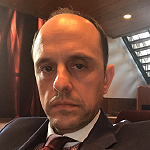
Sotir Stavridis
Name: Sotir Aleksandar Stavridis
Education: PhD Thesis given in 2014 at the Medical Faculty in Skopje
Professional training and clinical fellowships:
- 2000, London UK, three months Clinical attachment at St. Peters Hospital, Institute of Urology and Nephrology, under supervision of Prof. Antony Mundy and Prof. Christopher Woodhouse
- 2003, Training on Laparoscopic Surgery, Bordeaux, France
- 2005, Training on Laparoscopic Urology under supervision of Prof. Nado Vodopija, Slovenia
- 2008, Vienna, Austria, three months Clinical Fellowship at Algemeine Krankenhaus in Vienna, Clinic of Urology, under supervision of Prof. Mihael Marberger sponsored by the EAU
- 2012, Zagreb, Croatia, Clinical Attachment and coordination for implementation of organizational and technical structure of the cadaveric transplantation within the Eurotransplant association at the Clinical Center Zagreb under supervision of Prof. Dr. Zeljko Kastelan
- 2015, Istanbul Turkey, Training on PCNL and PCNS, Lufti Kerdar Hospital, Kartal, Istanbul, Turkey under supervision of Prof. Kemal Sarica
Current occupation:
- 1999 - present: working at the University Clinic of Urology in Skopje
It is a University Clinic, with 40 beds and 3 operating theatres, emergency 24/7, oncological surgery, laparoscopy, living and deceased donor transplantation, BPH, stone treatment - 2001 - present: taking part in the education of the medical students in the field of surgery and urology as junior assistant professor
Membership & Meetings:Senior activities:
- 2005 - 2007: ESRU member and Macedonian National Communication Officer
- 2007 - present: Active EAU member
- 2004 - 2010: Treasurer of the Macedonian Association of Urology
- 2010 - present: Secretary General of the Macedonian Association of Urology.
Lecture. INDICATIONS FOR URINARY STENTS
All kinds of urinary stents are used today in the everyday urological practice.
In general the indications of the insertion of all urinary stents is to achieve free flow of urine.
First urinary stents were introduced in the practice in the late 19th and early 20th century, and were associated with many complications like encrustations, stent migration and expulsion.
Today the ureteral stents have become a perfect tool for achieving urine drainage after certain operations or a pain reliever in acute renal/ureteral/urethral obstruction.
There are several types of stents, concerning the area of placement, the shape, their durability, length of stay and the material they could be made of.
A review on all the indications, placement and potential problems and remarks will be discussed in the lecture concerning the following:
- Nephrostomy tubes
- Ureteral stents
- Urethral stents
Throughout the last 20-30 years a lot of different
Several practical issues/questions will be discussed, so we could find or determine the ideal urinary stent.


